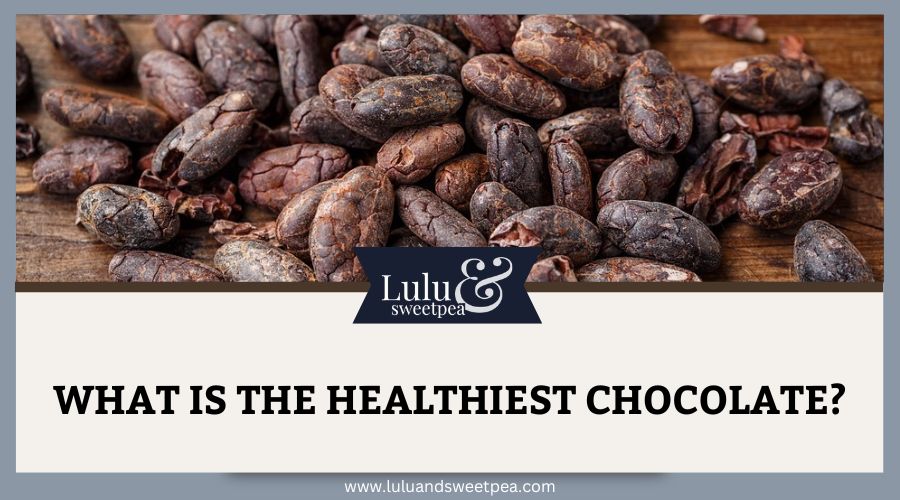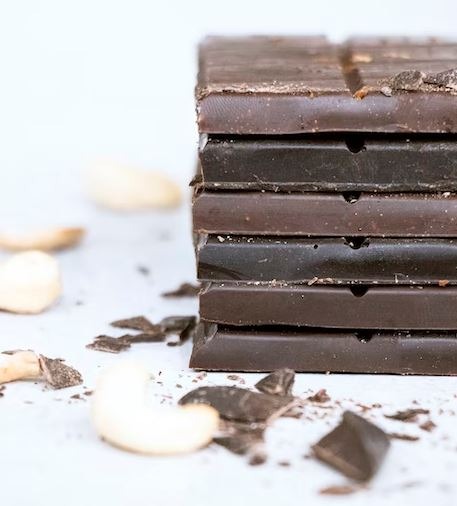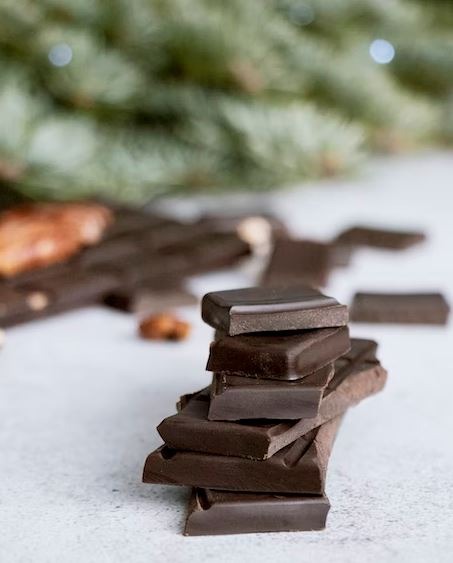Chocolate is one of life’s most decadent treats. Most people love it – as a candy bar, cake or dessert flavor, hot drink, or drizzled over ice cream – because it’s just exquisite and satisfying. It’s hard to imagine a world without chocolate.
Though it’s delicious, it’s not always nutritious or even made of real chocolate at all. But there is one type of chocolate that’s significantly healthier than the rest, and that is dark chocolate.
Dark chocolate is an ultra-rich superfood that has been shown to improve memory, keep your heart healthy, decrease inflammation and boost mood. The next time you pick a treat for a dessert or for your Halloween goodies, try going for dark chocolate instead of the other varieties.
Where Does Chocolate Come From?
Before we talk about the health benefits of chocolate, it’s interesting to know where it comes from. We may have been used to seeing chocolate in its processed form, but it’s good to know that it comes from natural materials with promising health benefits.
Making chocolate is a long process. After the seeds are harvested from cacao pods that grow on small trees, they are fermented, dried, and roasted into cacao beans. Dried cacao beans are crushed to make raw cacao nibs. From there, the nibs go through different processes that result in the many forms of chocolates – from bars to liquids to powders. Nibs are ground up to get cocoa paste or cocoa liquor. Cocoa solids are produced when the cocoa fat or butter is removed from cocoa paste. When cocoa solids are dried, cocoa powder is created.
Chocolate has been beloved since way back in 1,900 BC when the Mesoamericans first started drinking it as a frothy, fermented beverage. It’s a well-loved food that was once called the “drink of the gods” by the Maya people. It was most likely cultivated by the Maya people for about 2,500 years, and by about 2,000 years ago, the Maya experienced cacao bean farmers who liked grinding them up to make a hot beverage. Later on, the Aztecs continued this love for chocolate, then the Spanish discovered this drink in the 1500s and brought it around the world.
What is Dark Chocolate?
When it comes to the healthiest chocolate type, the answer is simple: it’s dark chocolate by a landslide. Since dark varieties contain more cocoa content, it gets more flavanols and all the goodness that cocoa offers than milk chocolate.
Dark chocolate is created by adding fat and sugar to cocoa, and it differs from milk chocolate because it contains little to no milk solids. It’s known as bittersweet or semisweet chocolate, which differs in sugar content, but can be used interchangeably in cooking and baking. You can know that the chocolate is dark if it has 70 percent or higher total cocoa content.
Since dark chocolate contains higher cocoa contents, the bitter they taste. And that’s why the tastier milk chocolate adds milk and sugar and lessens cocoa to sweeten things up. Unfortunately, eating something made primarily of saturated fat and sugar is not good for your health.
Dark chocolate is known for its potent antioxidant activity. Surprisingly, it has more significant antioxidant effects than antioxidant-heavy fruits like blueberries and acai berries. Also, observational studies showed that eating dark chocolate is linked to a reduced risk of heart disease and improved brain function.
How Does Dark Chocolate Compare to Other Types of Chocolate?
Many of the benefits of chocolate come from flavanols, which contain antioxidants, and have a very bitter taste. But when it’s alkalized, roasted, or fermented, the bitter taste gets neutralized, and the flavanols start to disappear. Dark chocolate contains a cocoa percentage between 65 and 99%, and this is why it’s more bitter than other forms of chocolate.
Meanwhile, milk chocolate contains around 35% to 55% cocoa mass, but by law in the US, a milk chocolate bar needs to contain a minimum of 10% cocoa mass – which means you might be getting very little chocolate content and loads of sugar and fat. White chocolate is made of pure cocoa butter, milk powder, and sugar and doesn’t offer any health benefits. In the EU and US, a bar of white chocolate is required to contain a minimum of 20% cocoa butter and no more than 55% sugar or sweeteners. White chocolate is the least healthy option and has the highest sugar content.
Health Benefits of Dark Chocolate
Chocolate can be a health food if you go for the most nutritional option: dark chocolate, that’s at least 70% cocoa. Here are some of the health benefits you can get out of it:
1. It’s nutritious.
High-quality dark chocolate contains minerals and a decent amount of soluble fiber. A quarter cup (about 1.5 oz.) of dark chocolate contains:
- 3 grams of fiber
- 2 grams of protein
- 15 grams of carbohydrates
- 10 grams of fat
- 11 grams of sugar
- 142 calories
- No sodium and cholesterol
It also offers a good mix of minerals, including:
- Iron
- Zinc
- Magnesium
- Phosphorus
- Copper
2. It contains antioxidants.
Dark chocolate contains compounds with antioxidant properties, such as flavanols, polyphenols, and theobromine. Antioxidants help prevent oxidative stress, which contributes to the natural aging process and the development of different diseases. Eating moderate amounts of dark chocolate can help keep you young and free from aging-related ailments. Also, antioxidant compounds help protect cells from inflammation, improve brain health, and boost cardiovascular and immune health.
3. It lowers the risk of heart disease.
Regularly eating dark chocolate may help reduce a person’s risk of developing heart disease. Dark chocolate’s flavonols and some other compounds affect two major risk factors for heart disease: high cholesterol and high blood pressure.
Dark chocolate contains compounds such as polyphenols and theobromine, which may lower levels of bad cholesterol in the body and increase good cholesterol. According to a study published in the Journal of the American Heart Association, adding dark chocolate, cocoa, and almonds to your diet without exceeding caloric needs may help reduce the risk of coronary heart disease. Dark chocolate bars with almonds will be a great treat for you.
Meanwhile, the flavonols in the dark can help improve blood flow and lower blood pressure by stimulating nitric oxide production, which causes blood vessels to dilate. A study investigated the effects of dark chocolate consumption in people with type 2 diabetes and high blood pressure, revealing that it could help significantly lower blood pressure. However, the impact of dark chocolate on blood pressure might be more significant in older people at risk of cardiovascular diseases than younger healthy individuals, according to another study.
4. It has anti-inflammatory effects.
Inflammation is part of the body’s natural immune response to germs and other harmful substances. But chronic inflammation can damage tissues and cells, making you susceptible to various health conditions, including arthritis, type 2 diabetes, and some types of cancer. Dark chocolate compounds have anti-inflammatory properties that may help reduce inflammation in the body.
5. It helps reduce insulin resistance.
When the body stops responding to the hormone insulin, insulin resistance happens, which can cause abnormally high blood glucose levels. Too much glucose in the blood can lead to prediabetes and type 2 diabetes. A study’s findings suggest that eating 48 grams of 70% dark chocolate each day may help reduce insulin resistance and lower fasting glucose levels. Turns out, you can eat chocolate to prevent diabetes, after all!
6. It can help improve brain function.
The benefits of dark chocolate don’t stop there. It can also help improve your brain function. Studies show that eating dark chocolate can improve blood flow to the brain in young adults, and eating cocoa daily appears to improve memory, attention, and verbal learning.
A study suggests that the flavonols in dark chocolate can help enhance its neuroplasticity so that the brain can reorganize itself, especially as a response to diseases and injury. It helps maintain cognitive function in older adults and reduces the chance of mild cognitive impairment from progressing to dementia.
7. It can help digestion.
Eating dark chocolate can help increase the diversity of the gut microbiome, which aids digestion. A study suggests that eating 85% dark chocolate may have a positive correlation with mood, which is the benefit caused by the increased diversity of the microbiome.
Buying Tips for a Healthy Dark Chocolate
When buying dark chocolates, it is best to choose those made with as few ingredients as possible. The best dark chocolates are made with chocolate liquor or cocoa listed as the first ingredient. Several forms of cocoa may be on the list, like cocoa powder, cocoa nibs, and cocoa butter, all of which are acceptable dark chocolate ingredients.
Other ingredients are added to dark chocolate to improve its flavor, appearance, and shelf life. Some of these ingredients are safe, while some can harm the quality of the chocolate. Here are some of the ingredients you need to check when buying dark chocolates.
1. Keep an eye out for these ingredients:
- Sugar – Sugar is added to dark chocolate to lessen the bitterness. But when it becomes too much, it contradicts the health benefits you might get from dark chocolate. It’s hard to find dark chocolate that doesn’t have added sugar, and some brands tend to go overboard. A good rule of thumb is to choose a brand that doesn’t list sugar as the first ingredient or choose one that lists sugar last. The higher the cocoa percentage, the lower the sugar content will be.
- Lecithin – Lecithin is sometimes added to dark chocolates as an emulsifier. It helps blend the flavors and keep the cocoa and cocoa butter from separating. Lecithin is commonly derived from soybeans and is usually listed as soy lecithin on the label. It is used in such small amounts in chocolate, and it does not affect health or quality. When looking for a good brand of dark chocolate, keep in mind that lecithin isn’t a must-have ingredient, nor poses any concern on quality or health effects.
- Milk – High-quality dark chocolates should not contain any milk. But there’s an exception which is milk fat. Milk fat is butter that has had its moisture and non-fat solids removed. It is sometimes added to dark chocolate to add flavor and soften it. Like lecithin, it’s not required for dark chocolate, but if you’re looking to get the most health benefit, it’s best to choose one that doesn’t contain milk.
- Flavorings – Since dark chocolate is bitter, it is often flavored with extracts, oils, and spices to improve its taste. The most common flavoring used in dark chocolates is vanilla. However, it doesn’t always say on the label whether the flavors used are natural or artificial. So, if you want to buy dark-flavored chocolates, choose organic ones to ensure the flavors used are not artificial.
- Trans-fat – Avoid dark chocolate that contains trans fat. It’s because the consumption of trans-fat is a significant risk factor for heart disease. Today, adding trans-fat to chocolates has become less common; however, manufacturers sometimes still add it to improve consistency and lengthen shelf life. It has trans-fat if you see hydrogenated or partially hydrogenated oil in the ingredients list.
2. Cocoa must be the first ingredient.
Dark chocolate brands have a wide range of cocoa percentages. If you’re looking for quality dark chocolate, look for bars that have 70% cocoa or more. A higher percentage of cocoa means there’s a higher concentration of nutrients and antioxidants.
When buying, choose a dark chocolate brand that lists cocoa as its first ingredient, as the ingredient with the highest volume in the product is listed first.
3. Do not buy alkalized or Dutched dark chocolate.
The process of treating chocolate with alkali is called Dutching, or alkalization. It is used to change the color of the chocolate and decrease its bitterness. However, according to several studies, this method can significantly reduce the number of antioxidants in chocolate. Therefore, if you want to get the most health benefits from dark chocolate, you need to avoid those that have been Dutched. You will know this by checking the ingredients list for something like “cocoa processed with alkali.”
4. Go for fair-trade and organic chocolate.
When buying dark chocolates, choose those made from fair-trade and organic cacao beans as much as possible. Growing and harvesting cacao beans is a strenuous process for the farmers and producers, so by buying fair-trade products, you can ensure that the cacao bean farmer earns a fair price for the chocolate. It’s also chosen organic because it reduces your exposure to artificial chemicals and pesticides sprayed on the beans.
How Much Dark Chocolate Should You Eat?
Chocolate manufacturers do not indicate the flavanol content of their products, so it’s hard to know how much dark chocolate a person should eat to maximize its health benefits. If you choose dark chocolate with at least 70% cacao solids, you will get the most benefits from chocolate.
However, chocolate is high in calories, and it contains sugar. Some may come with extra ingredients that can take away some of the health benefits, like caramel and marshmallows. You may take about an ounce of dark chocolate no more than three times a week.
Chocolate bars are hard to measure because they vary in size, but to help with portions, look at the packaging to see how many ounces are in the bar. Don’t try to consume a big bar in one sitting – keep away most of it in the fridge for you to enjoy the next day.



